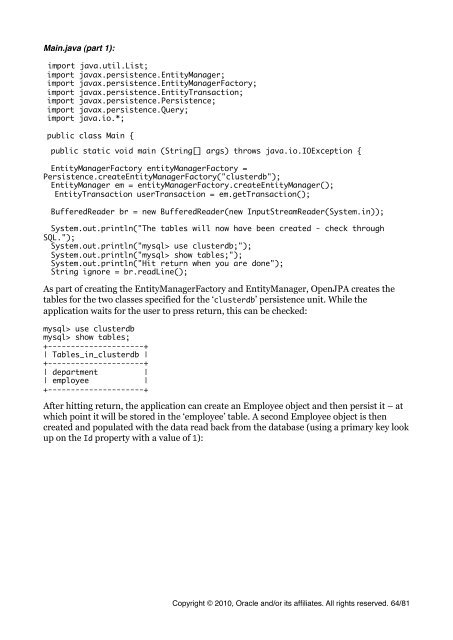MySQL Cluster Tutorial - cdn.oreillystatic.com
MySQL Cluster Tutorial - cdn.oreillystatic.com
MySQL Cluster Tutorial - cdn.oreillystatic.com
You also want an ePaper? Increase the reach of your titles
YUMPU automatically turns print PDFs into web optimized ePapers that Google loves.
Main.java (part 1):<br />
import java.util.List;<br />
import javax.persistence.EntityManager;<br />
import javax.persistence.EntityManagerFactory;<br />
import javax.persistence.EntityTransaction;<br />
import javax.persistence.Persistence;<br />
import javax.persistence.Query;<br />
import java.io.*;<br />
public class Main {<br />
public static void main (String[] args) throws java.io.IOException {<br />
EntityManagerFactory entityManagerFactory =<br />
Persistence.createEntityManagerFactory("clusterdb");<br />
EntityManager em = entityManagerFactory.createEntityManager();<br />
EntityTransaction userTransaction = em.getTransaction();<br />
BufferedReader br = new BufferedReader(new InputStreamReader(System.in));<br />
System.out.println("The tables will now have been created - check through<br />
SQL.");<br />
System.out.println("mysql> use clusterdb;");<br />
System.out.println("mysql> show tables;");<br />
System.out.println("Hit return when you are done");<br />
String ignore = br.readLine();<br />
As part of creating the EntityManagerFactory and EntityManager, OpenJPA creates the<br />
tables for the two classes specified for the ‘clusterdb’ persistence unit. While the<br />
application waits for the user to press return, this can be checked:<br />
mysql> use clusterdb<br />
mysql> show tables;<br />
+---------------------+<br />
| Tables_in_clusterdb |<br />
+---------------------+<br />
| department |<br />
| employee |<br />
+---------------------+<br />
After hitting return, the application can create an Employee object and then persist it – at<br />
which point it will be stored in the ‘employee’ table. A second Employee object is then<br />
created and populated with the data read back from the database (using a primary key look<br />
up on the Id property with a value of 1):<br />
Copyright © 2010, Oracle and/or its affiliates. All rights reserved. 64/81
















